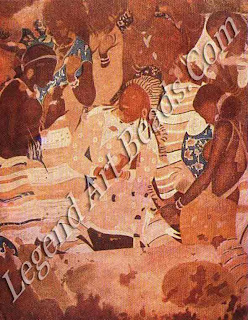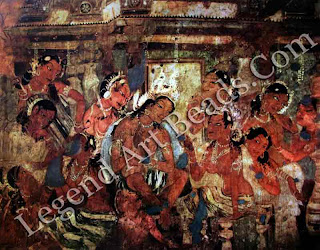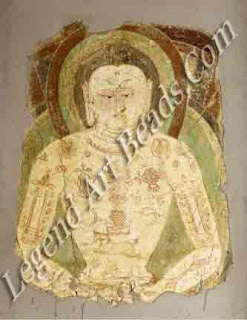Kushana
First to Third Century A.D.
The
Kushanas were the most powerful rulers after the Sungas in North India. Their
empire extended far beyond the normal known frontiers of India. In fact, having
moved on to India from Central Asia, they had their empire extending from
Central Asia through the modern territory of Afghanistan and Pakistan to beyond
Mathura in India. That is how there was a distinct school in the North-Western
Frontier, with a commingling of Indian, Graeco-Roman and Iranian elements, which
with Chinese influences made up a strange and interesting school of art,
offering fascinating facets of culture for studies. It is amazing how various
Indian motifs have found excellent expression and interpretation in Central
Asian sculpture and painting.
 This
painting from Central Asia, in the absence of paintings of this period in India
proper, forms the only source for study of the painter's art of the Kushana
period. A painting from Dandan Oiliq of a woman rising from the lotus pool
after her bath, with a child close to her, closely following similar Indian
representations, also recalls the expression of poets like Kalidasa, of greater
length of stalk of lotus, visible in summer, with the dwindling level of water
just reaching the waist of damsels, uddandapadmam grihadirghikanam narinitambadvayasam babhuva. The painting of Siva with three heads one fearful,
the central one calm, and the other feminine reminds us at once of similar figures
of the Gupta-Vakataka and early medieval age from India, the tradition itself
however being far earlier.
This
painting from Central Asia, in the absence of paintings of this period in India
proper, forms the only source for study of the painter's art of the Kushana
period. A painting from Dandan Oiliq of a woman rising from the lotus pool
after her bath, with a child close to her, closely following similar Indian
representations, also recalls the expression of poets like Kalidasa, of greater
length of stalk of lotus, visible in summer, with the dwindling level of water
just reaching the waist of damsels, uddandapadmam grihadirghikanam narinitambadvayasam babhuva. The painting of Siva with three heads one fearful,
the central one calm, and the other feminine reminds us at once of similar figures
of the Gupta-Vakataka and early medieval age from India, the tradition itself
however being far earlier.
A painting of Buddha from Balawaste, now in the
National Museum Collection of Central Asian Antiquities, is the most
interesting of all representations of Buddha from anywhere in the world. This
is a painting of the Kushana period with a clear srivatsa mark on the Master's
chest. We know that as a mahapUrusha Buddha has also this mark but always
covered by the cloak. It has never been presented in any of the Indian
representations of Buddha. The mountain Meru with the serpent Vasuki wound
round it in a pool is symbol of the churning of the ocean by the gods and
demons to bring out ambrosia. Chandrama, according to the Vedas, is ambrosia
that arose from the mind of the Viratpurusha, chandrama manaso jatah. Buddha is
here represented as Viratpurusha in the Visvarupa aspect.
 But the
most important of the symbols here shown on his body are the two on the arms, a
flaming pillar or a lotus, topped by three flames. The flames are shown as
leaves, as in the case also of the vajra symbol shown on Buddha's forearms. If
we recall the identical symbols of the flaming pillar on lotus from Amaravati
in the Krishna valley representing standing Buddha and the significance of the
superiority of Buddha, dharma and sangha over Brahma represented as lotus, and
pillar represented as Siva combining Agni, seen in the flames, we should really
wonder how the thoughts spread to such great distances. Only here we do not
have the solar wheel and the feet on the top and bottom of the flaming pillar
to suggest Vishnu and Surya, respectively.
But the
most important of the symbols here shown on his body are the two on the arms, a
flaming pillar or a lotus, topped by three flames. The flames are shown as
leaves, as in the case also of the vajra symbol shown on Buddha's forearms. If
we recall the identical symbols of the flaming pillar on lotus from Amaravati
in the Krishna valley representing standing Buddha and the significance of the
superiority of Buddha, dharma and sangha over Brahma represented as lotus, and
pillar represented as Siva combining Agni, seen in the flames, we should really
wonder how the thoughts spread to such great distances. Only here we do not
have the solar wheel and the feet on the top and bottom of the flaming pillar
to suggest Vishnu and Surya, respectively.
The
garland-bearers with a floral rhizome resting on the shoulder as in the case of
similar figures from Mathura and Amaravati of a contemporary date remind us of
how closely the motif of a style of the Kushana period resembles contemporary
Indian patterns elsewhere also in India.
Writer-
C. Sivaramamurti
 This
painting from Central Asia, in the absence of paintings of this period in India
proper, forms the only source for study of the painter's art of the Kushana
period. A painting from Dandan Oiliq of a woman rising from the lotus pool
after her bath, with a child close to her, closely following similar Indian
representations, also recalls the expression of poets like Kalidasa, of greater
length of stalk of lotus, visible in summer, with the dwindling level of water
just reaching the waist of damsels, uddandapadmam grihadirghikanam narinitambadvayasam babhuva. The painting of Siva with three heads one fearful,
the central one calm, and the other feminine reminds us at once of similar figures
of the Gupta-Vakataka and early medieval age from India, the tradition itself
however being far earlier.
This
painting from Central Asia, in the absence of paintings of this period in India
proper, forms the only source for study of the painter's art of the Kushana
period. A painting from Dandan Oiliq of a woman rising from the lotus pool
after her bath, with a child close to her, closely following similar Indian
representations, also recalls the expression of poets like Kalidasa, of greater
length of stalk of lotus, visible in summer, with the dwindling level of water
just reaching the waist of damsels, uddandapadmam grihadirghikanam narinitambadvayasam babhuva. The painting of Siva with three heads one fearful,
the central one calm, and the other feminine reminds us at once of similar figures
of the Gupta-Vakataka and early medieval age from India, the tradition itself
however being far earlier.  But the
most important of the symbols here shown on his body are the two on the arms, a
flaming pillar or a lotus, topped by three flames. The flames are shown as
leaves, as in the case also of the vajra symbol shown on Buddha's forearms. If
we recall the identical symbols of the flaming pillar on lotus from Amaravati
in the Krishna valley representing standing Buddha and the significance of the
superiority of Buddha, dharma and sangha over Brahma represented as lotus, and
pillar represented as Siva combining Agni, seen in the flames, we should really
wonder how the thoughts spread to such great distances. Only here we do not
have the solar wheel and the feet on the top and bottom of the flaming pillar
to suggest Vishnu and Surya, respectively.
But the
most important of the symbols here shown on his body are the two on the arms, a
flaming pillar or a lotus, topped by three flames. The flames are shown as
leaves, as in the case also of the vajra symbol shown on Buddha's forearms. If
we recall the identical symbols of the flaming pillar on lotus from Amaravati
in the Krishna valley representing standing Buddha and the significance of the
superiority of Buddha, dharma and sangha over Brahma represented as lotus, and
pillar represented as Siva combining Agni, seen in the flames, we should really
wonder how the thoughts spread to such great distances. Only here we do not
have the solar wheel and the feet on the top and bottom of the flaming pillar
to suggest Vishnu and Surya, respectively. 











0 Response to "Introduction to Kushana - Indian Painting"
Post a Comment